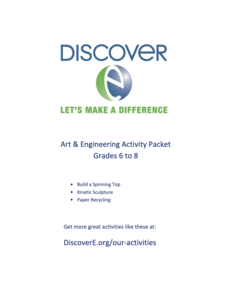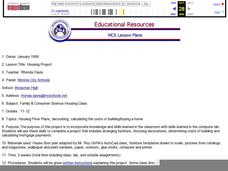California State Parks
Energy Flow Through an Ecosystem
One of the key concepts in life science and biology is the cycling of energy throughout an ecosystem. Learners can take notes on the topic using the vocabulary included within the presentation. From producers making their own food...
Curated OER
Math in Science-Knowing the Calories You Take In!
I can burn off one scrambled egg in 30 minutes of walking? Explain how we daily consume and burn calories using this fun worksheet, which breaks down basic foods and activities into kilocalorie equivalents. Nutritionists calculate the...
California Academy of Science
Using Empirical Data in the Classroom: Raptor Migrations!
Raptor flight patterns align with seasonal changes in net primary productivity. Here is a thought-provoking lesson that uses empirical data from a video to help scholars understand raptor migrations, producers/consumers, and ecosystems....
Curated OER
Consumerism
Students examine the techniques that companies use to sell their products. In this consumerism lesson students create an ad for a company and create a handcrafted butterfly.
Beyond Benign
The Story of Cosmetics Video Assessment
Does your shampoo contain carcinogens? Scholars learn how cosmetic companies create and market their products, many of which contain toxic chemicals. They examine the bias and consumer responsibilities in the industry.
It's About Time
Who Eats Whom?
Packed with visual aids and multiple learning opportunities, an engaging exercise challenges individuals as they explore the role of producers, consumers, and decomposers. After discussing differences between food chains, food...
Teach Engineering
Fun Look at Material Science
Introduce materials science with a class demonstration. After showing a PowerPoint presentation on materials and their properties, instructors provide a ceramic tile, a Popsicle stick, a paper clip, and a plastic bag as examples of...
Baylor College
Your Energy Needs (BMR)
How many Calories one needs on a daily basis is dependent on a number of factors including gender, height, and activity level. In the third of seven lessons about energy and food, young nutritionists calculate the number of Calories...
DiscoverE
Art and Engineering Activity Packet: Grades 6-8
Build an appreciation of engineering. Pupils in grades 6-8 learn about science and engineering in a set of three engaging activities. They build spinning tops, construct wind structures, and create recycled paper as part of an engaging...
Curated OER
Prairie Food Chains & Webs
Students complete a food chain. In this ecosystem lesson, students learn about producers, consumers and decomposers. Students identify herbivores, carnivores and omnivores and complete two worksheets.
Curated OER
Agriculture Pays
Second graders role play one of the jobs related to agriculture and explain their role in getting one of the five "f's" of agriculture to the consumer. In this agriculture lesson, 2nd graders are assigned a role and a commodity. Each...
Curated OER
A Day Without Agriculture
Second graders define and create a list of agricultural products. In this producers and consumers lesson, 2nd graders participate in a contest to find as many types of agriculture as they can. The student who comes up with the best...
Curated OER
Using Dialogue Journals in Support of Science Instruction
High schoolers build a dialog journal within their science class. They develop written responses to questions asked by the teacher in a journal notebook. Teachers have the responsibility to read and respond to student responses.
Curated OER
The Science of Sleep and Daily Rhythms: Sleeping in Space
Students write about strange places that they have slept. For this sleep science lesson students read about astronauts sleeping experience in space. They reflect on unusual places that they have slept and write about it.
Curated OER
Identify And Classify
In this consumer awareness activity, students learn that hazardous household products have words that identify the risk. Students view 54 photos of common household substances. Students sort them into piles according to the hazard risk.
K12 Reader
What’s Eating You?
Introduce your class to producers, consumers, and pollinators with a reading passage. Class members read the text and respond to five related questions.
National Endowment for the Humanities
Upton Sinclair, Theodore Roosevelt, and Harvey W. Wiley
Though Upton Sinclair's novel The Jungle shocked the American public into a thorough examination of the meat-packing industry, the author was disappointed that his book's main argument—the exploitation of American immigrants—was not part...
Carnegie Mellon University
Home Energy Audit
Youngsters make a mental assessment of electricity-consuming appliances in their homes and then evaluate them for the amount of energy consumed. They learn how to use power meters and measure the electrical consumption of several...
Curated OER
Housing Project
Find everything you need for a two-week home construction simulation project for your high school economics class. They come up with the plans for a custom home including the cost per square foot, interest rate, mortgage term, down...
Curated OER
Science: Grade 4
Building a scientific vocabulary is important for all students and this presentation provides a list of words typical to 4th grade science curriculum. Tip: Adding images to this resource will make the vocabulary more accessible to ELLs...
Curated OER
Producers, Consumers, and the Food Chain
Third graders discuss producers, consumers, and the food chain. In this producers and consumers lesson plan, 3rd graders talk about organisms, the food chain, and the difference between producers and consumers. They complete review...
Curated OER
Solar Kit Lesson #9 - Properties of Solar Radiation: Reflection, Transmission, and Absorption
Middle school science stars observe and record data on the solar radiation reflected off or transmitted through various materials. They predict properties for various materials, and test their predictions by touch. This lesson becomes...
Captain Planet Foundation
Energy Flow in the Garden
How can you tell what an owl has eaten? Study the food chain and flow of energy in an ecosystem by dissecting an owl pellet and noting the bones found inside. Additionally, the lesson includes a game about consumers and producers with a...
Safe Drinking Water Foundation
Water Bottles Everywhere
Young environmentalists examine how water bottle use is polluting the waters on our earth. In groups, your students study the handout on their assigned topic and present their findings to the rest of the class. Leading up to this lesson,...
Other popular searches
- Family and Consumer Sciences
- Family Consumer Science
- Consumer Science Foods
- Consumer Science Manners
- Health and Consumer Science
- Consumer Science Fibers
- Consumer Science Fibres
- Fm & Consumer Science
- Family & Consumer Sciences
- Consumer Science Fib Res
- Consumer Science Careers
- Food and Consumer Sciences

























